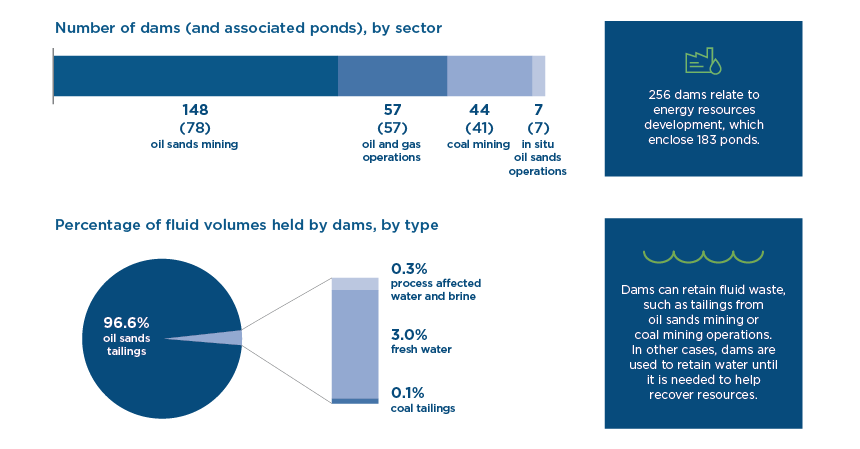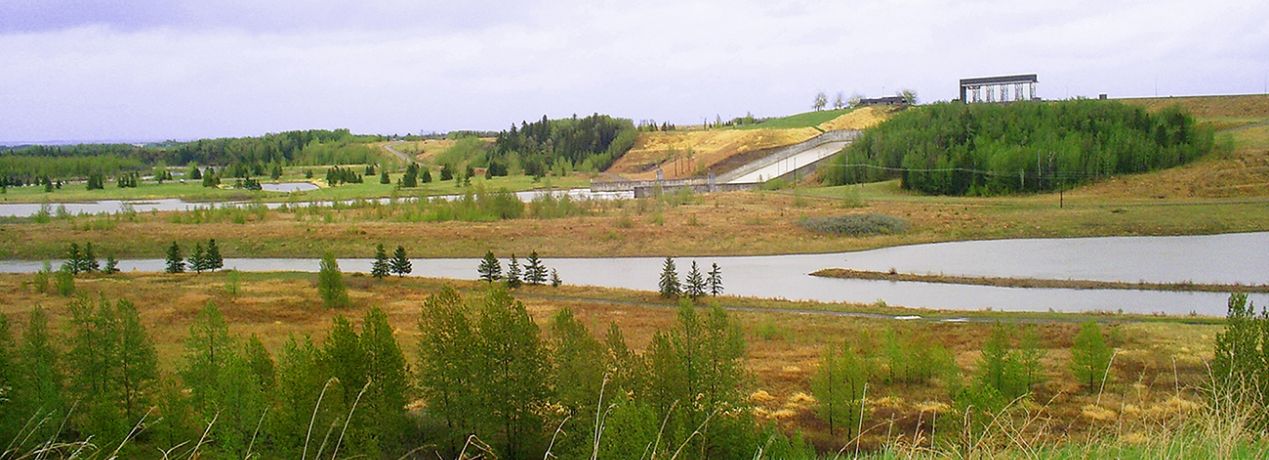Many energy companies in Alberta use dams when developing energy resources. Dams are barriers designed to hold back fluids and are often constructed using earthfill materials, such as clay and sand. A dam, or multiple dams, together with the reservoir (also known as a pond) make up a fluid storage facility.
How do energy companies use dams?

Companies use dams to retain various types of fluids depending on the type of energy development activity. In some cases, dams retain fluid waste, such as tailings from oil sands mining and coal mining operations. In other cases, dams are used to retain water until it is needed to help recover resources, such as for hydraulic fracturing.
Oil sands tailings is by far the largest volume of all the fluids impounded at 96.6 per cent of the total approved capacity. The remaining volume is taken by fresh water, process-affected water, and coal tailings.
The AER regulates 256 dams related to energy resources development, which enclose 183 ponds used for oil sands mining (78), coal mining (41), oil and gas operations (57), and in situ oil sands operations (7). All other dams in the province are regulated by Government of Alberta.
More detailed information about the dams we regulate can be found on our interactive Dam and Pond Map.

How We Regulate Dams
We’re committed to holding industry accountable for the safety of their dams.
Our dam safety program ensures companies follow regulatory requirements for the safe design, construction, operation, maintenance, and decommissioning or closure of their structures, which are outlined in Part 6 of the Water (Ministerial) Regulation and the Alberta Dam and Canal Safety Directive. Examples of how we ensure companies follow our requirements include conducting dam inspections and reviewing regulatory submissions, such as annual performance reviews, dam safety reviews, and emergency management plans. Dams that enclose tailings ponds are inspected every year. The remaining dams are inspected at a frequency based on their consequence classification.
AER staff participate in technical committees and working groups, including those in the Canadian Dam Association (CDA), which allows dam safety experts from Alberta, Canada, and around the world, to share their expertise and experiences. These forums ensure that Alberta considers global best practices and is leading when it comes to providing regulatory oversight of dams.
To help ensure dams are safe, companies must continuously monitor and assess their structural integrity to ensure that risks are mitigated. This includes reporting any performance issues they identify and taking the necessary actions to resolve them.
Companies are also required to report any dam-related incident and emergencies. While uncommon, due in part to stringent regulatory requirements, in the event of an incident, the company is responsible for leading the response and communicating with those affected. The AER is also involved throughout the incident response process to ensure that companies respond appropriately.
If a company isn’t meeting regulatory requirements, we’ll take action by applying one or more compliance and enforcement tools, including notices, orders, sanctions and fees, and even prosecution. These tools are outlined in Manual 013: Compliance and Enforcement Program. In all cases, the company is required to take the appropriate steps to address the noncompliance.
Information about incidents, and compliance and enforcement decisions can be found on our Compliance Dashboard.
Annual Dam Safety Program Report
Each year, the AER reports on the activities we undertake and the associated outcomes under the dam safety program. This includes inspection results and any noncompliances and safety deficiencies identified related to the structural integrity of dams. The annual report was developed as part our commitment to provide public information on the outcomes of the program, as recommended by the 2015 Auditor General of Alberta’s report Systems to Regulate Dam Safety.
For information about the activities we conducted in 2023 and a summary of industry compliance, please read our 2023 Dam Safety Program Report.


